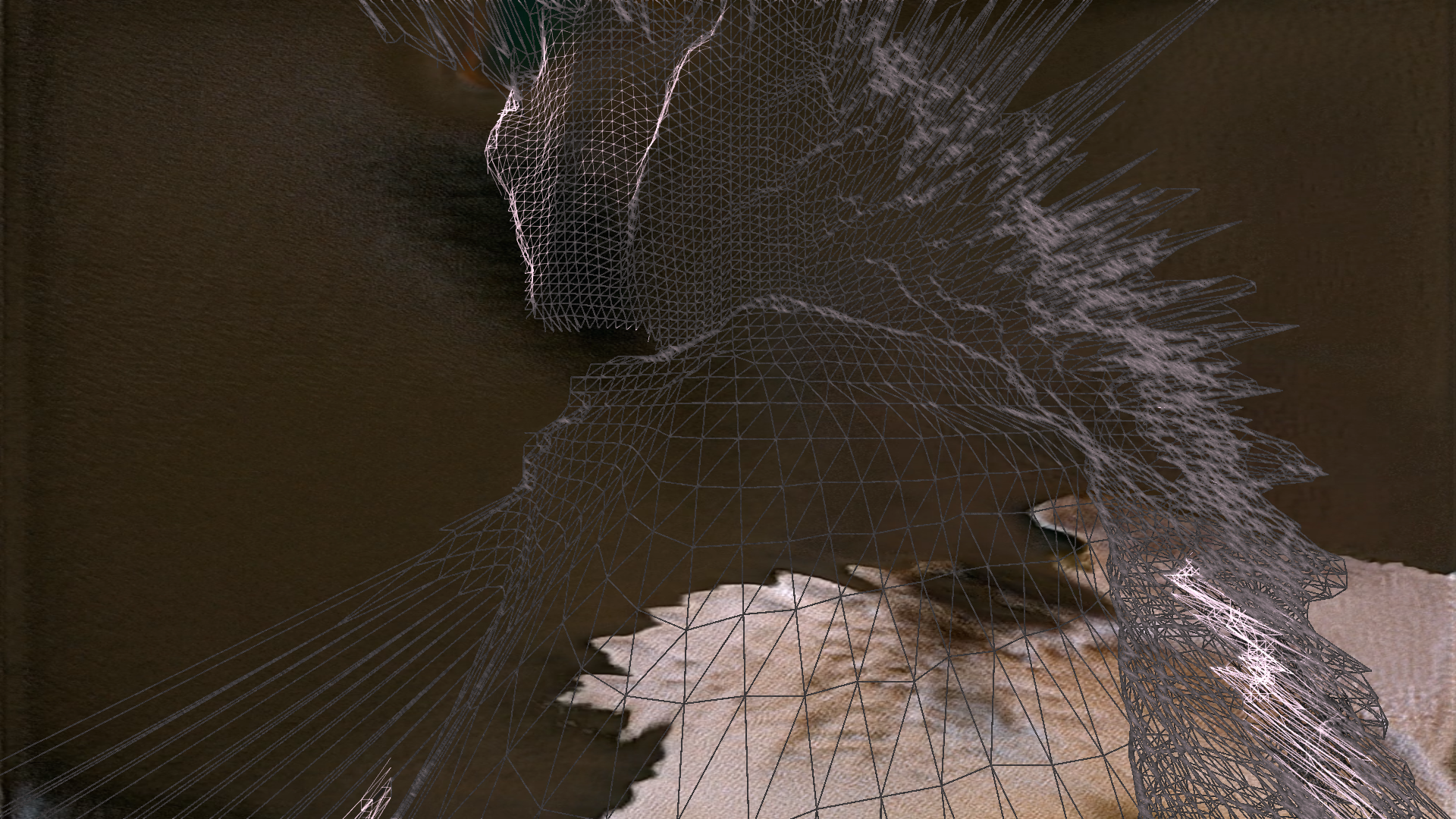Sibyl
Single channel video
2:30 min
LÁ Art Museum, Contemporary Art Museum Iceland 2024
Noass Art Center, Riga Latvia 2024
Li Tang Gallery, N.Y. 2022
Vidéoformes Clermont-Ferrand, France 2022
The Wrong Digital Art Biennale 2022
Synthetic Media Art Festival Taipei 2021
New Media Art Biennale Kiev, Ukraine 2021
ADAF Athens Digital Arts Festival 2021
Very High Stuff Exhibition at Le Dojo, Nice 2021
ADAF Athens Digital Arts Festival 2020
MADATAC XI Círculo de Bellas Artes Madrid 2020
Instants Vidéo Numériques et Poétiques 2020
Nam Sibyllam quidem Cumis ego ipse oculis meis vidi in ampulla pendere, et cum illi pueri dicerent: Σίβνλλα τί ϴέλεις; respondebat illa:άπο ϴανεΐν ϴέλω.
I saw with my own eyes the Sibyl at Cumae hanging in a cage, and when the boys said to her: “Sibyl, what do you want?” she answered: “I want to die.” Satyricon, Petronius - TS Eliot The Waste Land (1922)
Sibyl is a piece exploring the self-fulfilling prophecy of prediction. It was created using volumetric capture and GAN to explore the concept of intentionality and question the looping mirroring of AI predictability and machine learning, not as a predictive tool but rather, as a consolidation engine.
In Greek mythology, the Sibyl was a prophetess, an oracle, a seeress; usually female, acting as the “mouth” and “voice of God”. There seems to be an uncanny resemblance with the making of AI assistants by Silicon Valley: from Eliza, the first chatbot invented in 1964, to Alexa, Siri, Cortana, Mica, all the way to Google latest AI, Meena.
In uncertain, dark and anxious times, prediction and hindsight are indeed precious. As machine learning allows artificial intelligence to make faster, better predictions, we can argue that these are a mirror in a mirror, rather than a prediction.
Sibyl performs a repetitive dance in which every movement starts and ends in the same way, in a mirroring loop.
Sibyl is a single channel video loop, created by merging volumetric capture techniques, video processing and StyleGAN, in which a model has been trained, based on a large data set of similar images, in order to obtain a not-so-surprising similarity with the original set.
The post GAN intervention is key to the piece and the idea of “intentionality”, and less in that of a certain autonomous random quality often present in AI generated aesthetics; the intent and intervention are present and necessary not only at the beginning, but at the end of the process, through a minutious and laborious digital, yet manually controlled frame by frame operation.
The GAN generated work is obtained through a "controlled prediction” of the initial intent, by selecting a specifically selected data model. The piece uses GAN not as a predictive tool but rather, as a consolidation engine. A way to question the machine learning prediction loop not only through the very manual intervention that "intentionally" sets the context and parameters of the process, but through the one that initiates it, controls it and determines its output throughout.
2:30 min
LÁ Art Museum, Contemporary Art Museum Iceland 2024
Noass Art Center, Riga Latvia 2024
Li Tang Gallery, N.Y. 2022
Vidéoformes Clermont-Ferrand, France 2022
The Wrong Digital Art Biennale 2022
Synthetic Media Art Festival Taipei 2021
New Media Art Biennale Kiev, Ukraine 2021
ADAF Athens Digital Arts Festival 2021
Very High Stuff Exhibition at Le Dojo, Nice 2021
ADAF Athens Digital Arts Festival 2020
MADATAC XI Círculo de Bellas Artes Madrid 2020
Instants Vidéo Numériques et Poétiques 2020
Nam Sibyllam quidem Cumis ego ipse oculis meis vidi in ampulla pendere, et cum illi pueri dicerent: Σίβνλλα τί ϴέλεις; respondebat illa:άπο ϴανεΐν ϴέλω.
I saw with my own eyes the Sibyl at Cumae hanging in a cage, and when the boys said to her: “Sibyl, what do you want?” she answered: “I want to die.” Satyricon, Petronius - TS Eliot The Waste Land (1922)
Sibyl is a piece exploring the self-fulfilling prophecy of prediction. It was created using volumetric capture and GAN to explore the concept of intentionality and question the looping mirroring of AI predictability and machine learning, not as a predictive tool but rather, as a consolidation engine.
In Greek mythology, the Sibyl was a prophetess, an oracle, a seeress; usually female, acting as the “mouth” and “voice of God”. There seems to be an uncanny resemblance with the making of AI assistants by Silicon Valley: from Eliza, the first chatbot invented in 1964, to Alexa, Siri, Cortana, Mica, all the way to Google latest AI, Meena.
In uncertain, dark and anxious times, prediction and hindsight are indeed precious. As machine learning allows artificial intelligence to make faster, better predictions, we can argue that these are a mirror in a mirror, rather than a prediction.
Sibyl performs a repetitive dance in which every movement starts and ends in the same way, in a mirroring loop.
Sibyl is a single channel video loop, created by merging volumetric capture techniques, video processing and StyleGAN, in which a model has been trained, based on a large data set of similar images, in order to obtain a not-so-surprising similarity with the original set.
The post GAN intervention is key to the piece and the idea of “intentionality”, and less in that of a certain autonomous random quality often present in AI generated aesthetics; the intent and intervention are present and necessary not only at the beginning, but at the end of the process, through a minutious and laborious digital, yet manually controlled frame by frame operation.
The GAN generated work is obtained through a "controlled prediction” of the initial intent, by selecting a specifically selected data model. The piece uses GAN not as a predictive tool but rather, as a consolidation engine. A way to question the machine learning prediction loop not only through the very manual intervention that "intentionally" sets the context and parameters of the process, but through the one that initiates it, controls it and determines its output throughout.



